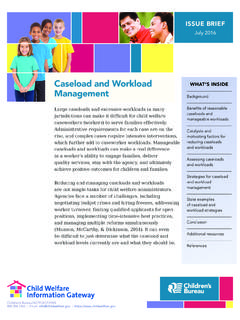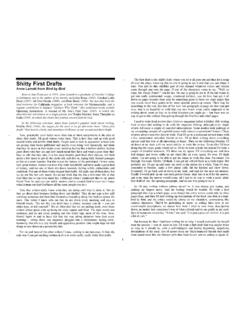Transcription of Taking a Closer Look at Stress - Centers for Disease ...
1 Post-Core: Stress and Time Management Taking a Closer Look at Stress Stress is part of everyone s life. Stress means different things to different people, and what causes Stress for one person may not cause it for another. If not managed properly, Stress can lead to illness, increased blood glucose levels, increased anxiety, or depression and mood swings. Forms of Stress may include: Physical stressors: fever, pain, illness Environmental stressors: weather, noise, housing concerns, traffic Social and emotional stressors: concerns over money, job and family demands, having to make a big decision, guilt, loss, and lifestyle change High levels of Stress can be a barrier to making healthy lifestyle changes.
2 Stress can cause people to: Lose interest in physical activity Become very inactive and withdrawn from daily activities Increase inactive behaviors such as excessive TV watching, playing on the computer, or sleeping Eat or drink too much National Diabetes Prevention Program: Post-Core 1 Post-Core: Stress and Time Management Stress and You Please take a moment and think about Stress and how it affects your life. 1. How often do you feel stressed? Often Sometimes Seldom 2.
3 How do you know you are stressed? Describe what happens. 3. List some of the things that are making you feel stressed right now. 4. What are some ways you deal with the Stress in your life? 5. Which of these ways of dealing with Stress do you think are negative or unhealthy? 6. Which of these ways of dealing with Stress do you think are positive or healthy? National Diabetes Prevention Program: Post-Core 2 Post-Core: Stress and Time Management Take Charge of Your Response to Stress Here are some tips for how to respond to stressful situations.
4 Practice saying No. Try to say yes only when something is important to you. Share some of your work or responsibilities with others. Ask a co worker to help you with a project, or ask a friend orfamily member to help out with a household task. Take charge of your your time, and make schedules that are practical. Make a To-Do list at the beginning of each day and label items: A (most important), B (important, but can be put off for a while), or C (not time-sensitive, can be put off). Combine errands. Go to the drug store and post office in one trip.
5 Double recipes when you cook, and freeze the other half to enjoy later. Use problem the problem in detail brainstorm your options pick one option to try make an action plan try it see how it goes. Plan about the kind of situations that are stressful for you. Plan for how to handle them or work around them. Don t put important things off plan for how you can address them. Keep things in perspective. Think of all the good things in your life, and try to maintain a positive attitude. Reach out to comfort and support in others.
6 Focus on healthy food, get enough sleep, practice relaxation techniques (such as meditation or prayer), be physically active, and laugh often. Find healthy ways to respond to to identify Stress as early as possible. Take a 10 minute time out to pamper yourself, be active, or try a relaxation technique. National Diabetes Prevention Program: Post-Core 3 Post-Core: Stress and Time Management Strategies for Saving Time with Physical Activity Consider these time savers that you could add to your physical activity routine.
7 Save time getting motivated to do physical activity: Set an alarm; when the alarm goes off, go! Have a friend or family member meet you at a regular time. Ask a friend or family member to call you to remind you. Join a walking club, gym, aerobics class, etc. Other ideas: Save time getting ready: Keep your exercise shoes and clothes in the car or at your office. Set out your exercise gear the night before. Choose a place to get physical activity that is close to your home or work. Other ideas: Save time by combining physical activity with other tasks or opportunities: Use a 10-minute break during the day to take a brisk walk.
8 Ride an exercise bike while you watch the news or listen to the radio. Walk and talk with friends or family members. Walk, run, or bike in a community event that benefits a good cause. Walk or bike to work, or to the store for errands. Take your child for a brisk walk in a stroller. Take up an active hobby (dancing, swimming, hiking, etc.). Mow the lawn or shovel snow for an elderly neighbor. Other ideas: Save time after being physically active: Be physically active right before the time when you would be showering anyway (such as first thing in the morning or in the evening).
9 Other ideas: National Diabetes Prevention Program: Post-Core 4 Post-Core: Stress and Time Management Make Time to Relax Relaxation Technique: Belly Breathing Follow these steps to practice proper belly breathing. Practice Belly Breathing 1. Lie down or sit comfortably. Bend your knees, with your feet on the floor about eight inches apart. Make sure your spine is straight. 2. Now put one hand on your belly. Put the other hand on your chest. Breathe in slowly and deeply through your nose.
10 3. Gently press down on your belly as you breathe out your nose. Let your belly push your hand back as you breathe in. Let your chest move just a little, as it should follow the movement of your belly. Use belly breathing when you notice yourself getting tense. Once you have learned the technique, you can do it while sitting or standing. Try it while you are stuck in rush hour traffic or waiting in line at the grocery store you will be surprised what a difference it can make! National Diabetes Prevention Program: Post-Core 5 Post-Core: Stress and Time Management 6 Make Time to Sleep Getting Enough ZZZs: How much is enough?
















